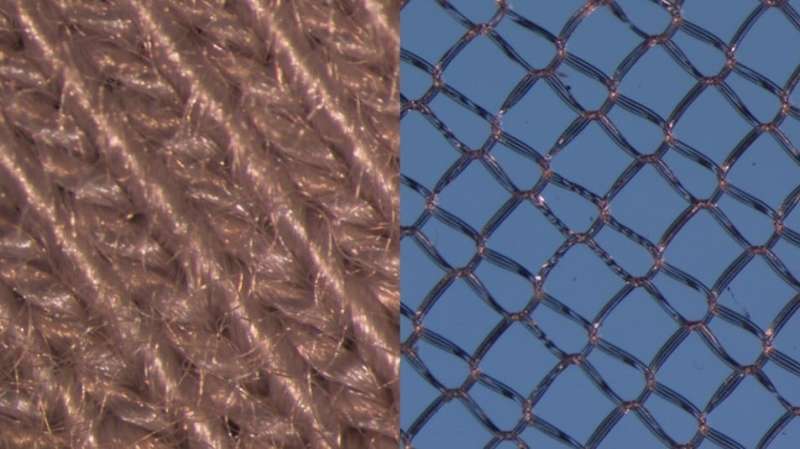Textile waste is a problem: How researchers want to solve it

In the United States, 11 million metric tons of textile waste go into landfills every year. But what if we could make that waste disappear?
Sonja Salmon, associate professor of textile engineering, chemistry and science at North Carolina State University, is studying a process for separating blended fabrics into their component fibers so they can be recycled or composted.
Specifically, Salmon and Jeannie Egan, a graduate student at NC State, are studying whether they can use enzymes—nature’s tool for speeding chemical reactions—to separate cellulose, which is biodegradable, from polyester so these components can be used in other products, or used to make nutrient-rich compost for crops.
The Abstract spoke with Salmon and Egan about the problem of textile waste.
The Abstract: Why are you looking at textile waste?
Salmon: A lot of old clothing ends up in the landfill. Someone made an estimate that the average lifespan of a piece of apparel is about five years. With fast fashion, you hear about wearing something once and then throwing it away. Every year, 11 million metric tons of waste is dropped into U.S. landfills, and at least 60 million metric tons is disposed globally. There it sits. What if we could make it disappear?
TA: What are some of the ways that people are looking at solving this problem?
Egan: There are things consumers are doing to reduce waste accumulation. Secondhand shopping and clothing rental services are becoming more and more popular. That’s not just people renting tuxedos for prom. It’s a movement trying to change fast fashion from a linear waste stream to a rentable space. Other people are making attempts at turning fabric into an insulation material. And we’re working on trying to separate textile components into fibers so they can be recycled individually or composted.
TA: Is composting of textiles a thing yet?
Salmon: There are very few research studies on putting textile waste into compost. There’s no agency saying you should compost your textiles; unlike disposable plastics, where there are regulations saying you can’t throw disposable plastics into a landfill. We were inspired by disposable plastics to say that maybe there is a portion, not all, of textile waste that could go to composting. Here we would be talking about cotton, the natural fibers. Polyester cannot be composted.
TA: So that’s why you need to separate them?
Salmon: Most of our textile waste comes from two materials, or polymers. One is cellulose, and it’s a natural fiber found in cotton, and polyester. The fact that many textiles are a blend of different fiber types is what makes them such an awful waste, unlike a single-use plastic that is just made of one material. These two textile components are different. It’s really impossible to mechanically separate them. Because the individual fibers are twisted together very tightly at the yarn level, you can’t unravel them.
TA: How are you proposing to separate them?
Salmon: We are proposing a chemical method of separation. We are studying a method of using our favorite biocatalysts, enzymes, to go in there and chew up the cotton part and separate it so you end up with clean polyester that you can recycle. From the digested cotton, you end up with this fine fiber material that you can pump with a liquid spray into a compost pile. It’s another option for these little tiny fibers; they are a waste, but if you put them into compost, they might be a useful waste.
TA: Where are you now with this research?
Egan: So far, what we’ve found is we can convert 100% cotton fabric into a pump-able slurry. Now we’re trying to collect data to learn about the system so we can optimize it. We’re starting to look at how the dyeing or finishing process might hinder the process of enzymatic degradation, to analyze the factors that contribute to what makes it work and the bacterial populations we need, and how we can do this on a larger scale.
TA: What’s your expectation for the future?
Salmon: There’s a very interesting future ahead for textiles. Because people are very conscious now, they are trying to think about how we can make new kinds of textile fibers that would be more sustainable. That’s the beauty and the challenge of a textile fiber. I’m also very excited by how seriously the top tier textile brands are taking the notion of sustainability.
Egan: I think home laundering is going to change, along with the waste stream. I think it comes down to where our society’s mentality is in regard to: who is responsible for the waste? Is it the person who bought it, or the supplier who made it? Maybe we’ll see more takeback programs, and a bigger shift in consumer awareness.
New approach to recycling synthetic textiles
Jeannie Egan et al, Strategies and progress in synthetic textile fiber biodegradability, SN Applied Sciences (2021). DOI: 10.1007/s42452-021-04851-7
Citation:
Textile waste is a problem: How researchers want to solve it (2022, April 25)
retrieved 25 April 2022
from https://techxplore.com/news/2022-04-textile-problem.html
This document is subject to copyright. Apart from any fair dealing for the purpose of private study or research, no
part may be reproduced without the written permission. The content is provided for information purposes only.
For all the latest Technology News Click Here
For the latest news and updates, follow us on Google News.

